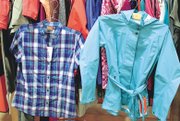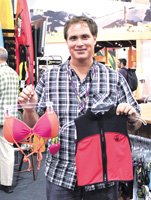Business Booming at Outdoor Retailer Summer Market
SALT LAKE CITY—Despite the tough economy, business was thriving at the Outdoor Retailer trade show, held Aug. 4–7 at the Salt Lake City Salt Palace.
“It was pretty clear to everybody that everyone was kind of shocked to see how many more people there were even though we had an extra 50,000-square-foot pavilion outside,” said Kenji Haroutunian, director of the show.
Transitional clothing and women’s apparel both proved to be popular this show.
“People are wearing active fashion from their practice into everyday life,” said Rich Hill, vice president of sales for San Diego–based lifestyle brand Prana.
More customers are looking for one outfit that can take them through the day and transition from yoga to hiking to out at night, he said.
Eighty percent of the buyers for Prana—which is carried by stores such as Nordstrom, REI and Drishti Yoga—had already secured orders before the show, but Outdoor Retailer enables the company to meet with local stores and buyers that have not already booked orders, Hill said.
He noted that items such as Prana’s high-end, versatile yoga pants, which retail for $80, were doing well because “everyone wants a part of yoga” and customers like when products come from a sustainable, socially conscious brand.
Irvine, Calif.–based Element Emerald Collection, which is owned by surf company Billabong, showed for the first time at Outdoor Retailer this year.
“It’s been a successful show for us,” said Kevin Via, national sales manager for the company. The brand’s eco-friendly ethos and more upscale outdoor look appealed to buyers, he said.
Men’s casual footwear had been selling exceptionally well, including the “Bowery” lace-up shoe, made with a bamboo liiner and pressed-hemp outsole, and the leather “Hampton Elite” boat shoe, made with a vibram sole, Via said. The newly launched brand will be carried at retailers including Fred Segal in Los Angeles.
The label’s women’s line, Element Eden, was also popular with buyers, according to marketing coordinator Alexandra Swanson. The company’s more innovative, fashion-driven approach to activewear was founded on the idea of being beautiful in every situation, she said. “Every piece is designed to be styled to fit any mood or time of day.”
The company’s lightweight striped wrap sweater and cotton mesh tank top, which retail for $64.50 and $29.50, respectively, were two of the line’s hot-selling items.
Nick Schwartz of Michigan-based footwear company Merrell, which has expanded into apparel over the last 3frac12; years, said the company’s women’s business was “on fire.”
Women’s apparel now constitutes 58 percent of the company’s total sales, whereas two years ago, men’s held that spot, according to Schwartz.
The brand’s brightly colored, belted, waterproof women’s rain shells, which retail for $99, were doing especially well at the show, he said.
“They buy this jacket, not this jacket,” Schwartz said, motioning to the popular “Mariposa” jacket versus a standard, box-shaped rain shell.
Women’s active-lifestyle dresses in bright solids and prints were also big sellers at Merrell. Many of them feature details such as four-way stretch fabric with wicking properties, built-in bras and UPF 50 sun protection.
“That category has been terrific,” Schwartz said.
Todd Davis of Body Glove, based in Redondo Beach, Calif., said the show had been better for hard goods, such as wetsuits and personal floatation devices, than apparel, but the company’s retro “time-warp” swimwear collection, recalling the bright neon colors of the ’80s, had been selling well.
Australian surf company Billabong also fared well.
“It’s been very good—better than we thought,” Angi Broberg, national sales manager for Billabong’s juniors division, said.
The brand’s Bob Marley collection—featuring tanks, T-shirts, boardshorts, bikinis and hats with the singer’s image and Rastacolors—has been wildly popular, according to Broberg. Billabong’s new juniors collection, made in collaboration with Australian surfer and blogger Oracle Fox, has also done well, she said.
Recession-proof?
Overall, the outdoor and action-sports industries have not been hit as hard as the rest of the apparel industry, according to exhibitors.
“Our industry is outpacing the general economy, and our company is outpacing the industry,” said Rich Hill of Prana.
Jess Clayton of Patagonia said this has been the company’s best year ever in terms of overall sales. “I think we’re a little bit immune to the recession.”
Customers respond to the brand because they know that the company is “hyper-aware” of environmentalism, and they would rather put their money into a high-quality product that will last longer, she said.
Patagonia’s “Kamala” dress, a brightly colored, striped piece made for transitioning from outdoor activities to everyday wear, had been doing very well at the show, as well as “stayput” bikinis, which stay in place during water sports, Clayton said.
Kent Stevens, vice president of sales for Quiksilver, said the company has been showing at Outdoor Retailer for six years and that this was a strong show. Buyers had been booked hourly for a total of 75 to 80 accounts, and they had also opened new accounts, he said.
Stevens said the popularity of outdoor apparel might be a result of the slow economy encouraging customers to spend more time doing outdoor activities, which can cost less than other hobbies.
There was double-digit growth in the number of buyers at Outdoor Retailer compared with last year’s summer market, jumping from roughly 6,300 last year to just under 7,000 this year, Haroutunian said. There was also an uptick in the number of exhibitors, which grew from around 1,130 last year to an estimated 1,300 this year, 244 of which were new to the show.
Whether or not the show has become too big for Salt Lake City’s Salt Palace has been a “lively discussion” that has gone on for a number of years, he said. “We’re very conscious of that and of the right growth-strategy development. We’re working with the Outdoor Industry Association and other industry leaders to develop a vision for that growth and to cap it in a limited way.
























